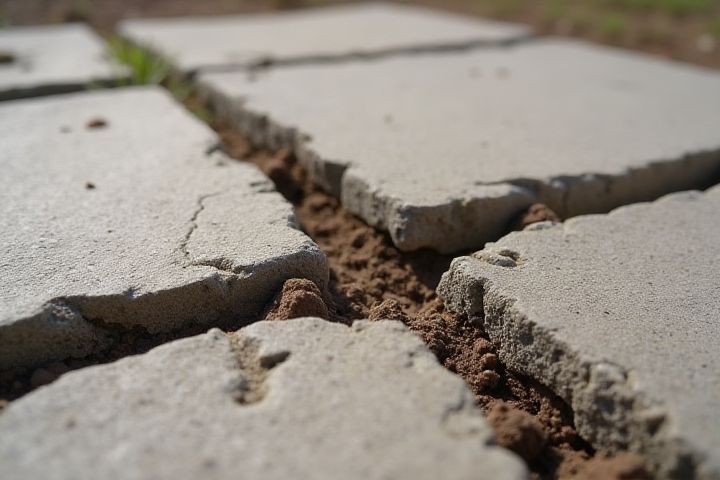
To check for house foundation cracks, start by examining the exterior walls for vertical or horizontal fissures, as these may indicate structural issues. Pay attention to areas around windows and doors, as misalignment or gaps can signal underlying foundation shifts. Inside your home, inspect the basement or crawl space, looking for cracks on the floor or walls, which could suggest settling or heaving. Use a level to determine any significant slope or unevenness in floors, which may further corroborate foundation problems. Regular monitoring of these signs can help maintain the structural integrity of your home and prevent costly repairs.
How To Check House Foundation Cracks
Assess crack width and length
To effectively assess house foundation cracks, begin by measuring both the width and length of each crack. Use a crack gauge or ruler for precision; widths over 1/8 inch may indicate structural issues requiring professional evaluation. Document the length in relation to the total foundation area, as longer cracks can signify more severe problems. Observing changes over time, such as growth in width or length, can help you determine if the issue is worsening and if immediate action is needed.
Identify crack location and pattern
To check house foundation cracks, start by meticulously inspecting the perimeter of your home, paying special attention to areas around windows and doors, as these are common stress points. Identify the crack's location; vertical cracks often indicate normal settling, while horizontal or diagonal cracks may signal more significant structural issues. Take note of the crack pattern; if cracks widen or deepen over time, this could suggest ongoing settlement or water damage. For future reference, document the size and characteristics of any cracks, measuring them periodically to track changes.
Examine vertical vs. horizontal cracks
To assess the integrity of your house foundation, it's crucial to examine cracks closely, focusing on their orientation. Vertical cracks, typically ranging from hairline to wider splits, can indicate settling issues but may not always be serious. In contrast, horizontal cracks often signal more severe problems related to water pressure or soil shifts, particularly if they exceed 1/4 inch in width. You should measure the cracks with a ruler to determine their size and consult a professional if horizontal cracks are present, as they may require immediate attention.
Check for stair-step patterns in bricks
To assess your house foundation for potential issues, examine the exterior brick walls closely for stair-step patterns. These diagonal cracks can indicate shifting or settling of the foundation, which may compromise the structural integrity of your home. Measure the width of any cracks; significant gaps, larger than a quarter-inch, warrant further investigation. Regular monitoring of these patterns can help you identify changes over time and determine if professional evaluation is necessary.
Inspect for moisture or water damage
Inspecting your house foundation for cracks involves focusing on moisture and water damage signs. Look for any visible cracks wider than 1/4 inch, as these may indicate underlying structural issues. Pay attention to damp spots, mold growth, or peeling paint around the foundation, which often signal water intrusion or leaks. Ensure your gutters and downspouts are directing water away from the foundation, as improper drainage can exacerbate existing cracks and lead to further damage.
Monitor for changes over time
To effectively monitor foundation cracks in your house, regularly inspect key areas, such as corners of windows, doors, and the foundation's perimeter. Document each crack's size and width using a measuring tool, targeting any shifts greater than 1/8 inch, as this may indicate structural issues. Mark the cracks with a pencil or take photographs to track changes over time, noting the dates of your observations. Conduct these inspections every few months or after significant weather events, such as heavy rain or shifting temperatures, to ensure you catch any potential problems early.
Look for misaligned doors or windows
To assess your house foundation for cracks, begin by examining doors and windows for misalignment; if they stick or fail to close properly, this may indicate underlying foundation issues. Measure any gaps between the frames and the walls, noting discrepancies of more than 1/4 inch which suggest significant movement. Look along the corners of windows and doors for visible cracks, especially horizontal or zigzag patterns that indicate stress on the foundation. Regular checks, ideally every few months, can help you catch potential problems early, protecting your investment in your home.
Evaluate surrounding soil condition
To evaluate surrounding soil conditions that may affect house foundation cracks, begin by examining the type of soil and its drainage capabilities. Clay soils, for instance, are prone to expansion and contraction with moisture changes, which can exacerbate foundation issues. Measure the distance from the foundation to the nearest tree or large shrub, as roots can cause soil displacement; ideally, this distance should be at least 10 feet. Finally, inspect for signs of erosion or pooling water near the foundation, as both can compromise stability and lead to further cracking.
Consider foundation type
To check for foundation cracks, first determine the type of foundation your home has, such as slab, crawl space, or basement. For slab foundations, inspect the interior floors for cracks that may widen or have a stair-step pattern along walls. In crawl spaces, look for cracks in the perimeter walls and any bowing or shifting that might indicate settling. For basement foundations, pay attention to horizontal and vertical cracks, which can signal serious structural issues, especially if they exceed 1/8 inch in width.
Consult a structural engineer
You should consult a structural engineer if you notice cracks in your house foundation. A professional will assess the size, width, and depth of the cracks, with particular attention to those wider than 1/4 inch, which may indicate significant issues. They use specialized tools and techniques to evaluate the stability of your foundation and can recommend necessary repairs or reinforcements. This expert analysis is crucial for preventing further damage and ensuring the safety and structural integrity of your home.
